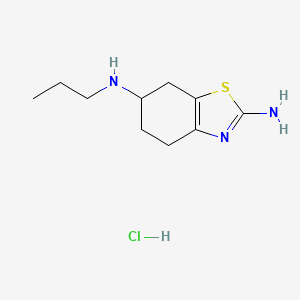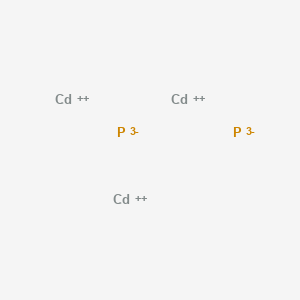
6-N-propyl-4,5,6,7-tetrahydro-1,3-benzothiazole-2,6-diamine;hydrochloride
- Click on QUICK INQUIRY to receive a quote from our team of experts.
- With the quality product at a COMPETITIVE price, you can focus more on your research.
Overview
Description
®-Pramipexole (dihydrochloride), also known as R-(+)-Pramipexole (dihydrochloride) and KNS-760704 (dihydrochloride), is a small molecule drug developed by the University of Virginia. It is a free radical scavenger, dopamine receptor agonist, and apoptosis inhibitor. This compound has been investigated for its potential therapeutic effects in various conditions, including hypereosinophilic syndromes, amyotrophic lateral sclerosis, and chronic obstructive pulmonary disease .
Preparation Methods
Synthetic Routes and Reaction Conditions
The synthesis of ®-Pramipexole (dihydrochloride) involves several steps, starting from commercially available starting materialsThe reaction conditions typically involve the use of organic solvents, catalysts, and specific temperature and pressure conditions to ensure high yield and purity .
Industrial Production Methods
Industrial production of ®-Pramipexole (dihydrochloride) follows similar synthetic routes but on a larger scale. The process is optimized for cost-effectiveness, scalability, and compliance with regulatory standards. This involves the use of large-scale reactors, continuous flow processes, and stringent quality control measures to ensure the consistency and safety of the final product .
Chemical Reactions Analysis
Types of Reactions
®-Pramipexole (dihydrochloride) undergoes various chemical reactions, including:
Oxidation: Involves the addition of oxygen or the removal of hydrogen.
Reduction: Involves the addition of hydrogen or the removal of oxygen.
Substitution: Involves the replacement of one functional group with another.
Common Reagents and Conditions
Common reagents used in these reactions include oxidizing agents (e.g., hydrogen peroxide), reducing agents (e.g., sodium borohydride), and various catalysts (e.g., palladium on carbon). The reaction conditions vary depending on the specific reaction but generally involve controlled temperature, pressure, and pH .
Major Products
The major products formed from these reactions depend on the specific reaction pathway. For example, oxidation may yield hydroxylated derivatives, while reduction may produce dehydroxylated compounds .
Scientific Research Applications
Chemistry: Used as a model compound for studying free radical scavenging and dopamine receptor agonism.
Biology: Investigated for its effects on cellular apoptosis and oxidative stress.
Medicine: Explored as a therapeutic agent for conditions such as hypereosinophilic syndromes, amyotrophic lateral sclerosis, and chronic obstructive pulmonary disease.
Mechanism of Action
®-Pramipexole (dihydrochloride) exerts its effects through multiple mechanisms:
Dopamine Receptor Agonism: Activates dopamine receptors, leading to increased dopamine signaling.
Free Radical Scavenging: Neutralizes free radicals, reducing oxidative stress and cellular damage.
Apoptosis Inhibition: Inhibits programmed cell death, promoting cell survival
Comparison with Similar Compounds
Similar Compounds
Pramipexole (dihydrochloride): A non-selective dopamine receptor agonist used in the treatment of Parkinson’s disease.
Ropinirole (hydrochloride): Another dopamine receptor agonist used for similar indications.
Rotigotine (transdermal system): A dopamine agonist administered via a transdermal patch for Parkinson’s disease and restless legs syndrome.
Uniqueness
®-Pramipexole (dihydrochloride) is unique due to its combined properties of dopamine receptor agonism, free radical scavenging, and apoptosis inhibition. This multifaceted mechanism of action makes it a promising candidate for various therapeutic applications, particularly in neuroprotection and anti-inflammatory treatments .
Properties
Molecular Formula |
C10H18ClN3S |
|---|---|
Molecular Weight |
247.79 g/mol |
IUPAC Name |
6-N-propyl-4,5,6,7-tetrahydro-1,3-benzothiazole-2,6-diamine;hydrochloride |
InChI |
InChI=1S/C10H17N3S.ClH/c1-2-5-12-7-3-4-8-9(6-7)14-10(11)13-8;/h7,12H,2-6H2,1H3,(H2,11,13);1H |
InChI Key |
YLOYRMPMRZXEMW-UHFFFAOYSA-N |
Canonical SMILES |
CCCNC1CCC2=C(C1)SC(=N2)N.Cl |
Origin of Product |
United States |
Synthesis routes and methods
Procedure details





Disclaimer and Information on In-Vitro Research Products
Please be aware that all articles and product information presented on BenchChem are intended solely for informational purposes. The products available for purchase on BenchChem are specifically designed for in-vitro studies, which are conducted outside of living organisms. In-vitro studies, derived from the Latin term "in glass," involve experiments performed in controlled laboratory settings using cells or tissues. It is important to note that these products are not categorized as medicines or drugs, and they have not received approval from the FDA for the prevention, treatment, or cure of any medical condition, ailment, or disease. We must emphasize that any form of bodily introduction of these products into humans or animals is strictly prohibited by law. It is essential to adhere to these guidelines to ensure compliance with legal and ethical standards in research and experimentation.













